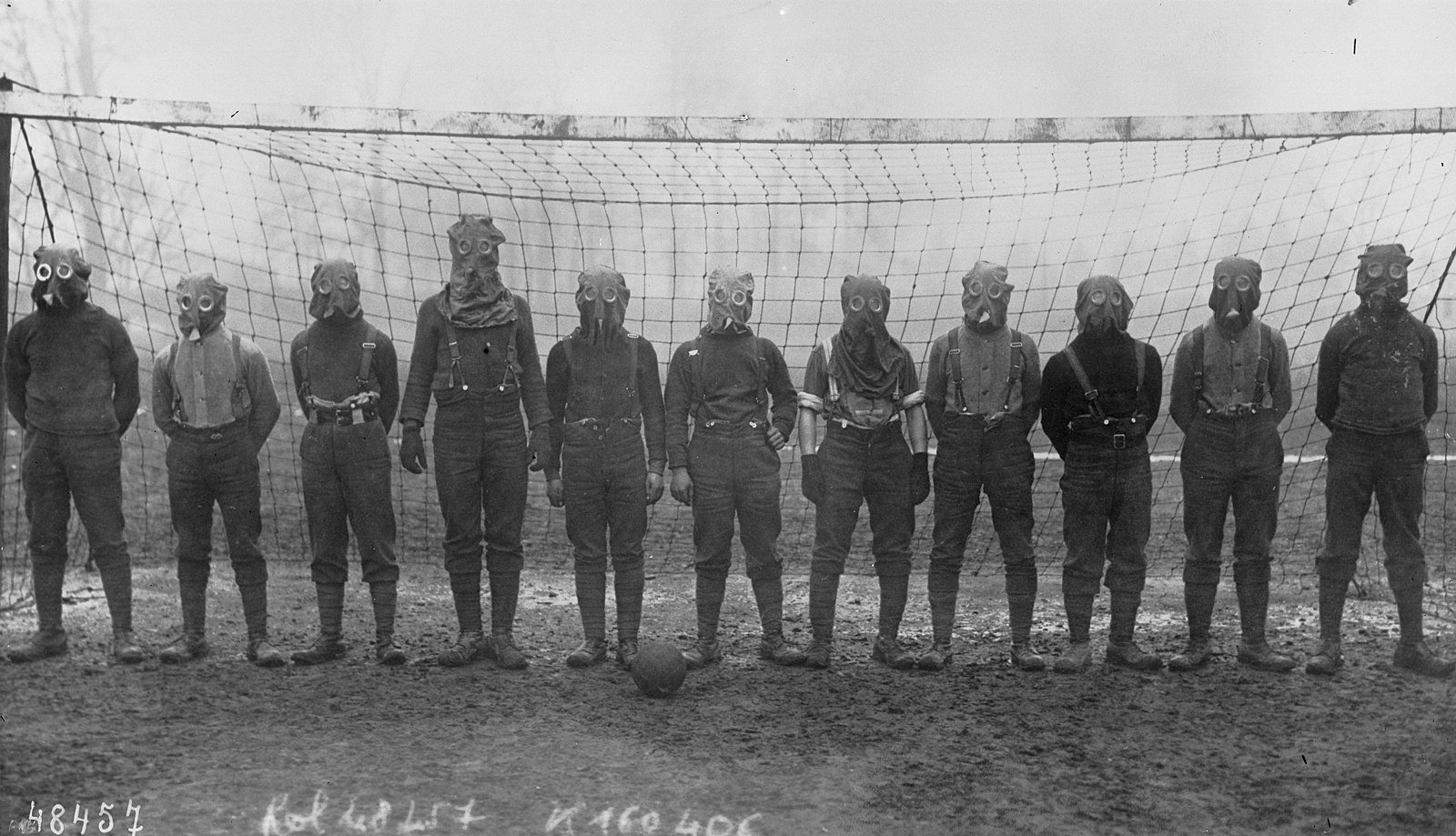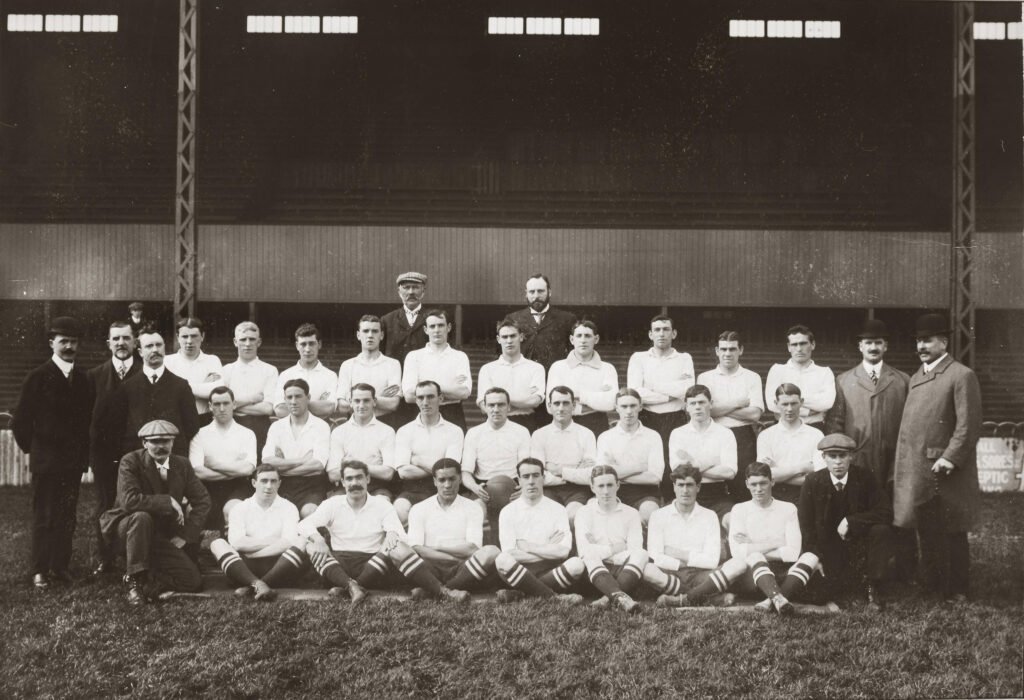The Footballers Battalions: Professional Soccer Players Who Fought in the Great War

Soccer team of British soldiers with gas masks, World War I, somewhere in Northern France, 1916. Photo courtesy of Wikimedia Commons.
During a war or national crisis, there are almost always debates regarding whether professional sports leagues should continue playing their games or if the players should instead exchange their uniforms and cleats for rifles and Army helmets. In August 1914, the British were on the doorstep of World War I, “the war to end all wars,” and questions were raised in the House of Commons as to what the Football Association (FA) and its players should do. Recruitment posters targeted the soccer players, who continued to practice and fill stadiums with fans.
Rugby and cricket, two other popular sports in Britain, joined the war effort without much convincing. “There was a time for all things in the world. There was a time for games,” Sir Arthur Conan Doyle wrote in September 1914. “But there is only time for one thing now, and that thing is war. If the cricketer had a straight eye let him look along the barrel of a rifle. If a footballer had the strength of a limb let them serve and march in the field of battle.”

Newspapers wrote sensational headlines, and public opinion called for the soccer season to be cancelled. An editorial published in The Times in November stated, “We view with indignation and alarm the persistence of Association Football Clubs in doing their best for the enemy.”
In December 1914, the British Army established the 17th (Service) Battalion of the Middlesex Regiment, the first football battalion composed of amateur and professional players, referees, and officials from more than 50 soccer clubs, including Liverpool, Arsenal, and Chelsea. Fans of the game also filled their ranks, inspired to join and serve alongside their favorite athletes. The FA had agreed to terms to allow new army recruits to compete in games held every Saturday, which provided a major morale boost for the soldiers who were on the front lines.

The 23rd (Service) Battalion, the second football battalion, formed in June 1915. Together, both infantry regiments saw heavy combat in trench warfare in France and suffered many casualties. The war claimed the lives of prominent soccer players including Walter Tull, a soccer prodigy who became the first black officer in British military history to lead white men into battle. Tull had experienced shell shock, or “acute mania,” and left the front lines in May 1916. He returned to participate in combat operations during the Somme offensive at Delville Wood, Guillemont, and the Redan Ridge. He was killed in action in March 1918 leading an attack during the second battle of the Somme offensive and was recommended for the Military Cross.
Throughout the Great War, an estimated 1,500 professional soccer players were killed in action. Two who were assigned to different regiments were awarded the Victoria Cross, the British military’s equivalent to the Medal of Honor. Lieutenant Donald Bell and Second Lieutenant Bernard Vann paid the ultimate sacrifice after they put the sport they loved behind them to fight for their nation.

Frank Buckley was another victim of World War I. He served as a major and commanded the first football battalion. He was badly wounded in the shoulder by a hand grenade, and his lungs were destroyed by gas attacks, which cost him his future of returning to Manchester United as professional soccer player. Despite his personal sacrifices, Buckley went on to become a different kind of field general — one of the greatest managers in the history of the British football. He led Wolverhampton “Wolves” Wanderers to two FA Cup victories.
Buckley was known for being a disciplinarian coach, having the fittest team in the league, and for revolutionizing the growth of the game by introducing new strategies. He advanced training and the culture toward fitness regiments, he provided dietary instruction of what his players could eat and drink, and he even improved scouting reports to a national scale.
The soldiers — all 4,500 who served in the Football Battalions — played a small but important role by bringing more than just their fighting spirit to the battlefield. They also helped increase morale through a sport that served as a respite from the battlefield. In 2010, former SAS soldier and professional soccer player Phil Stant helped bring a memorial to Longueval, France, dedicated to the Football Battalions and their wartime sacrifices.

Matt Fratus is a history staff writer for Coffee or Die. He prides himself on uncovering the most fascinating tales of history by sharing them through any means of engaging storytelling. He writes for his micro-blog @LateNightHistory on Instagram, where he shares the story behind the image. He is also the host of the Late Night History podcast. When not writing about history, Matt enjoys volunteering for One More Wave and rooting for Boston sports teams.
BRCC and Bad Moon Print Press team up for an exclusive, limited-edition T-shirt design!
BRCC partners with Team Room Design for an exclusive T-shirt release!
Thirty Seconds Out has partnered with BRCC for an exclusive shirt design invoking the God of Winter.
Lucas O'Hara of Grizzly Forge has teamed up with BRCC for a badass, exclusive Shirt Club T-shirt design featuring his most popular knife and tiomahawk.
Coffee or Die sits down with one of the graphic designers behind Black Rifle Coffee's signature look and vibe.
Biden will award the Medal of Honor to a Vietnam War Army helicopter pilot who risked his life to save a reconnaissance team from almost certain death.
Ever wonder how much Jack Mandaville would f*ck sh*t up if he went back in time? The American Revolution didn't even see him coming.
A nearly 200-year-old West Point time capsule that at first appeared to yield little more than dust contains hidden treasure, the US Military Academy said.












